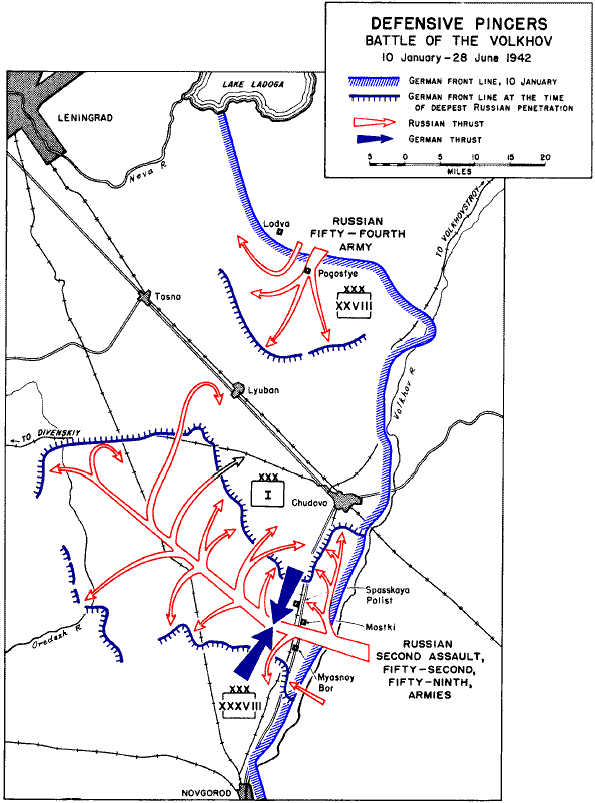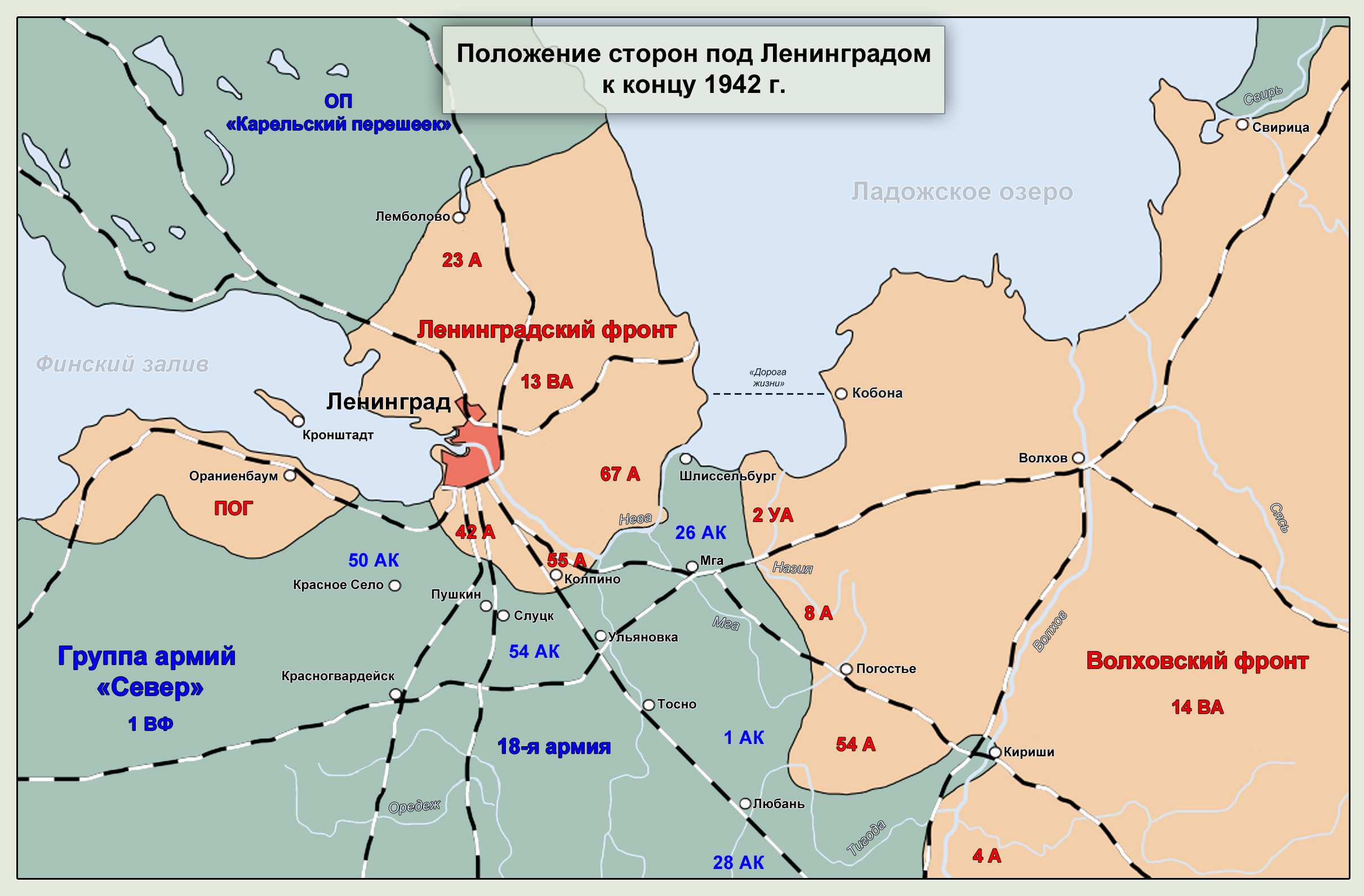Jesk argues that the cause for this phenomenon is Adolf Hitler, as we can see in many of his posts ( viewtopic.php?p=2174743#p2174743 , viewtopic.php?f=76&t=238783&p=2173631&h ... r#p2173631 , viewtopic.php?f=76&t=237197&p=2174748&h ... r#p2174748 , viewtopic.php?f=76&t=238783&p=2173388&h ... r#p2173388 , etc.).
I argue that the cause for this phenomenon is the operational reality, because HGN & HGM were nowhere near strong enough to mount offensives in face of the very costly battles they fought to hold their lines. They did have offensive plans however, but they were unable to set them in motion.
I. Phase : The Soviets deal a serious blow to the HGM & HGN (January – February 1942)
Let me pick up the thread in HGM’s sector right after the initial phase of the Soviet winter offensive, at the beginning of the so-called Rzhev-Vyazma Strategic Offensive Operation (8 January 1942 – 20 April 1942). The frontline of HGM was disrupted. Its right flank, the 2. Army and 2. Panzer Army (M. von Weichs / R. Schmidt), which was holding positions near Orel, was attached to the HGS at the beginning of 1942. North of that was the 4th Army (G. Heinrici) and the 4th Panzer Army (R. Rouff), positioned around Vyazma and Smolensk, defending the neck of the Rhzev salient. (The latter was soon to be transferred to the South for Case Blue.) The most exposed was the 9th Army (W. Model), occupying the salient itself. The northern flank became the 3rd Panzer Army (G.-H. Reinhardt), stationed near Vitebsk and Polotsk.
The Rzhev-Vyazma Strategic Offensive Operation aimed to destroy the Rhzev salient and thus annihilating the 9th Army and deal a critical blow to the 4th Army. The inital Soviet attack was successful, and the situation of the 9th and 4th Armies became desperate, especially because of the 1st Guards Cavarly Corps, 33rd Army and the 4th Airborne Corps operating in their rear .
In the AGN sector the Toropets–Kholm Offensive Operation (9 January – 6 February 1942) and the Lyuban Offensive Operation (7 January 1942 – 30 April 1942) took place. This resulted the encirclement of more than 100,000 German men by the end of January.
When army-sized groups of enemies operate in your backyard and your frontline troops became encircled, the most you can do is stabilize.
I think we can conclude that in January-February 1942 it was impossible for the HGN and HGM to attack, whether Adolf Hitler wanted it, or denied it; it was just so because of the operational reality.

II. Phase: The Germans fight back (March – May 1942)
As soon as the main forces of the attacking Western and Kalinin Fronts were brought to a halt, the AGM launched Operation Hannover, an offensive aimed to eliminate the partisans in their rear, supported by some units of the 4th Airborne Corps. The Germans annihilated the opposition with minimal losses. Later, the whole 29th Army and the better part of the 33rd Army got trapped in a cauldron. The commander of the 33rd Army, M. G. Yefremov attamepts to break out, but he did not succeed, and he shot himself in the head on 19 April. While some of them could escape to Soviet lines, the Germans annihilate the majority of these units.
You see, the HGM was soon to be deprived of the 2nd Army and the 4th Panzer Army, a huge portion of their offensive fighting strength. Case Blau required mobile units from the HGM.
After the Soviet troops became worned down by the battle of Volkhov, the AGN launched local offensives to relieve Demyansk and Kholm, which they succeed to do on 21 April and in 5 May, respectively.
I think we can conclude that despite in this period the Germans scored some important victories over the Soviets vital for their survival, they were still struggling to stabilize. The unit transfers to the South meant that in 1942 the HGM became less capable to mount offensives.
III. Phase: German summer offensive operations (June – July 1942)
Armeegruppe von Weichs, consisting HGM’s former units (2nd Army and 4th Panzer Army) is now being positioned at the northern flank of HGS and supported by the Hungarian 2nd Army. The unit scores a major victory as it moves forward to the Don, forming a cauldron with the northern flank of the 6th Army, in which ca. 4 Soviet Rifle Divisions (elements of the 21st and 40th Army) with 40,000 men gets trapped and destroyed. I cite this offensive here, because it was conducted exclusively by units which belonged to the HGM. I want to show you how much of the HGM’s offensive capabilities were redirected to HGS.
The HGM itself launches Operation Seydlitz on 2 July, encircling and completely destroying the 39th Army and the XI. Cavarly Corps in the upcoming 11 days of battle. The German frontline becomes 210 km shorter.

Having stabilized the situation at Leningrad with the Unternehmen Raubtier and with the successful relief of Demyansk and Kholm, HGN was conducting a massive encirclement against the salient which was held by the 2nd Shock Army (A. Vlasov), and elements of the 52nd and 59th Armies at the neck. The salient was cut off already in 19 March, but the 52nd and 59th Armies restored the connection on 27 March after a costly battle. The Germans once again commenced their offensive on 22 June, systematically cutting off and annihilating the encircled troops. Andrej Vlasov, the commander of the 2nd Shock Army becomes a POW on 12 Juli (later he becomes the commander of the Russian Liberation Army).

I think we can conclude that the Germans successfully mounted local offensive operations in this period, encircling and annihilating army-sized formations. Thus your argument about the never-attacking HGN & HGM is NOT true.
IV. Phase (August – November 1942): The German offensive plans and why they never happened
Further plans of offensives were conceived by Günther von Kluge, the commander of the HGM.
Source: https://codenames.info/operation/wirbelwind/With the end of ‘Seydlitz’ (iii) on 12 July, Heeresgruppe ‘Mitte’ was prepared to settle into an essentially defensive role for the summer. By their elimination of the most critical dangers to the army group’s rear, ‘Hannover I’, ‘Hannover II’ and ‘Seydlitz’ (iii) had made the army group once more an almost credible threat to Moscow and, consequently, something more than a current passive bystander in the war, but nevertheless offensive action was out of the question at least until a partial reorganisation and considerable reinforcement of the formation had been completed in August. The army group’s armies at this time had three operations in the early planning stages as ‘Derfflinger’, ‘Orkan’ (i) and ‘Wirbelwind’. An evolution from the earlier ‘Brückenschlag’, ‘Derfflinger’ was to be an offensive by Generaloberst Walter Model’s 9th Army, currently under the temporary command of Generaloberst Heinrich-Gottfried von Vietinghoff-Scheel, toward Ostashkov from the area of the front to the north of Rzhev. As suggested by their names, ‘Orkan’ (i) and ‘Wirbelwind’ were related operations to be undertaken by Heinrici’s 4th Army and Schmidt’s 2nd Panzerarmee against the Sukhinichi salient. In ‘Orkan’ (i) the two armies, striking from the north and the south, were to obliterate the entire salient and carry the front forward to Belev, Kaluga and Yukhnov, while ‘Wirbelwind’ was to be a considerably less ambitious alternative to ‘Orkan’ (i) designed merely to pinch off the western one-third of the salient and establish a new front line some miles to the east of Sukhinichi. Although ‘Orkan’ (i) could have been markedly more effective than ‘Wirbelwind’, through the reopening the south-western approaches to Moscow via Yukhnov and Kaluga, in the middle of July there was almost no chance of its implementation, unless there was a sudden Soviet collapse, as Heeresgruppe ‘Mitte’ lacked the strength in men and matériel to undertake so large an effort.
But what did just happen insted? The Soviets commenced their grand offensive on 30 July, the so-called First Rzhev–Sychyovka Offensive Operation. The Germans barely held their lines at the cost of all of their reserves.
A smaller form of Operation Wirbelwind was conducted, however, because of von Kluge’s insistence. The units of the 2nd Panzer Army was soon halted after some minor gains.
After the fall of Sevastopol in 4 July, the 11th Army with its 12 divisions was freed up, and as it was to be transferred to the HGN with its heavy artillery, the army group could finally build up an assault on the city according to the Führer-Anweisung Nr 41.

The HGN in fact planned 4 offensive operations:
- Unternehmen Nordlicht: the assault on Leningrad
- Unternehmen Schlingpflanze: enlargening the Demyansk salient
- Unternehmen Moorbrand: to eliminate the Pogostje salient
- Unternehmen Bettelstab: to capture the Bridgehead of Oranienbaum
None came to being eventually. Once again, why? Because the Soviets started their Sinyavino Offensive (August 19 – October 10, 1942). The Germans were able to hold them off until a reinforced counterattack once again cut off a huge part of the Red Army. But in the end their troops were too weak to start an offensive.
Summary: the Germans did attack in the HGN & HGM sector in 1942 when they had the chance, and when they could finally stabilize their lines in July, despite having further plans for large scale offensives, the immense Soviet attacks depleted their ranks. We could also conclude that the lack of major offensive operations in these sectors is not Hitler’s doing; the Germans simply didn’t have enough force.




